Barbara Kyle's Blog: The Rest of the Story
February 20, 2020
What Makes a Killer Mystery?
 There's a mystery at the heart of my new thriller,
There's a mystery at the heart of my new thriller, The Man From Spirit Creek.
What’s the difference between a "thriller" and a "mystery"?
Well, there's a lot of overlap. Both center on a crime. Thematically, the essence of both is that a terrible wrong has been committed in the world of the main character and it must be righted to restore balance and harmony.
A mystery almost always starts with a dead body, and always leads to an investigation by the main character, the "sleuth," whether that's a cop or a kindergarten teacher. And it climaxes in the eventual revelation of the murderer. These conventions apply whether the story is a psychological mystery, a police procedural, or a “cozy.”
In a thriller, the stakes are usually higher — a whole community might be at risk; sometimes a whole planet — and so is the suspense and the danger. There is often a looming fatal deadline. And, at a thriller's climax, the hero must take a big personal risk that finally defeats the antagonist.
Readers know these conventions and expect to see them fulfilled. Don’t misunderstand: conventions are not clichés. A cliché is the same old situation used to fulfill the convention, but there can be breathtakingly fresh ways to fulfill the convention.
Here are five mysteries that, for me, stood out as real page-turners.
 THE WIDOWS OF MALABAR HILL by Sujata Massey. Set in 1920s India, this story’s tremendous fascination springs from its depiction of the exotic world of three Muslim women, all widows living in full purdah, and the appeal of its main character, Bombay’s first female lawyer, whose dedication was forged by her own traumatic marriage.
THE WIDOWS OF MALABAR HILL by Sujata Massey. Set in 1920s India, this story’s tremendous fascination springs from its depiction of the exotic world of three Muslim women, all widows living in full purdah, and the appeal of its main character, Bombay’s first female lawyer, whose dedication was forged by her own traumatic marriage.  FIELD OF BLOOD by Denise Mina. I’m a big admirer of Scottish writer Mina and her gritty “Tartan Noir” fiction, whose Glasgow setting Booklist calls “spiky, gray, and grim.” Although those are apt descriptors, they don’t do justice to the majesty of Mina’s writing. The Publishers Weekly review says it best: “The brilliant Mina may have invented a subgenre: moral suspense...She spins the complexities in the rough music of her working-class Scots, unsparing of brutal details, but unfailingly elegant in her humanity.”
FIELD OF BLOOD by Denise Mina. I’m a big admirer of Scottish writer Mina and her gritty “Tartan Noir” fiction, whose Glasgow setting Booklist calls “spiky, gray, and grim.” Although those are apt descriptors, they don’t do justice to the majesty of Mina’s writing. The Publishers Weekly review says it best: “The brilliant Mina may have invented a subgenre: moral suspense...She spins the complexities in the rough music of her working-class Scots, unsparing of brutal details, but unfailingly elegant in her humanity.”  DREADFULWATER by Thomas King. Thumps DreadfulWater is a Cherokee ex-cop trying to make a living as a photographer in the small town of Chinook in the northwestern United States. King (who lives about a mile from my house) writes about the mild-mannered Thumps with such wit and charm, I was captivated.
DREADFULWATER by Thomas King. Thumps DreadfulWater is a Cherokee ex-cop trying to make a living as a photographer in the small town of Chinook in the northwestern United States. King (who lives about a mile from my house) writes about the mild-mannered Thumps with such wit and charm, I was captivated.  A DANGEROUS FICTION by Barbara Rogan. I couldn’t resist this story because of its setting: the New York publishing world in all its glamour, gossip, gall, and glory. The characters are richly complex; their dialogue sophisticated and tart. All this in a tightly written, suspenseful mystery that kept me turning pages to the last paragraph.
A DANGEROUS FICTION by Barbara Rogan. I couldn’t resist this story because of its setting: the New York publishing world in all its glamour, gossip, gall, and glory. The characters are richly complex; their dialogue sophisticated and tart. All this in a tightly written, suspenseful mystery that kept me turning pages to the last paragraph. AGENT RUNNING IN THE FIELD by John le Carré. The latest novel by this bestselling master of spy lore is technically not a mystery but a thriller, but I include it here because I cherish le Carré for his unflinching focus on the corrosive corporate and political powers who leash our lives, the heartbreaking authenticity of his characters, and the grace and wisdom of his prose. And, at its center, there is a mystery.
AGENT RUNNING IN THE FIELD by John le Carré. The latest novel by this bestselling master of spy lore is technically not a mystery but a thriller, but I include it here because I cherish le Carré for his unflinching focus on the corrosive corporate and political powers who leash our lives, the heartbreaking authenticity of his characters, and the grace and wisdom of his prose. And, at its center, there is a mystery. INGREDIENTS OF A MYSTERY
Here’s my 5-point checklist of the major elements of a page-turner mystery.
1. Multiple Suspects. The more characters who fall under suspicion, the better. Not only does this keep the reader guessing “who done it?” it also gives the author opportunities to create original, arresting characters, from the eccentric to the malevolent.
2. Escalation of the Danger. A dead body is the inciting incident in any mystery novel. Then, as the main character investigates leads in this crime, the jeopardy escalates. Perhaps there is a second murder victim. Or perhaps the main character is personally threatened. Or perhaps someone they love becomes endangered.
3. Active Reader Involvement. Successful mystery authors let the reader piece together information. Mystery readers want to follow subtle clues dropped throughout the book. They relish deciding whether a character is telling the truth or lying. They are eager to sift multiple possible explanations.
4. Red Herrings. Hunting dogs used to be trained by placing a dried herring, which turns red after being smoked, on the trail of the prey so the fishy scent confuses the dog. Thus, in fiction, a “red herring” means a clue or piece of information intended to be misleading or distracting. A compelling mystery story scatters red herrings throughout to keep the reader from correctly guessing the culprit of the central crime. This escalates the tension and suspense.
5. Satisfying Climax and Resolution. A satisfying mystery climax may leave the reader feeling “I saw that coming!” or “I didn’t see that coming!” and either way it makes perfect sense given X, Y, and Z. The book’s ending answers questions the story has spun, or reveals truths about characters who were falsely suspected. The revelation of the killer’s identity never feels like a trick. And, ideally, the climax relates clearly to the book’s beginning, its inciting incident.
I hope this sparks exciting ideas for your mystery novel. Write on!
All my best,
Barbara Kyle
February 8, 2020
A "Tartan Noir" Master
 Garnethill by Denise Mina
Garnethill by Denise MinaMy rating: 3 of 5 stars
Scottish author Denise Mina is a superb writer. She is a master at revealing the raw wounds that Glasgow's poor and powerless suffer, while at the same time creating female central characters who are resilient and resourceful. I loved her moving novel Field of Blood (review coming).
However, this first novel of her "Garnethill" trilogy was weighted down with so much extraneous material - long passages of detailed description, and flatline scenes that were mere set pieces - that by the time I was half-way through I was quickly scanning several pages at a time to skip the padding in search of developments in plot. An astute editor could have reduced this book's length substantially and made it a more gripping read.
Nevertheless, I still admire this wonderful writer and will definitely read more of her novels.
View all my reviews
February 4, 2020
Behind the Scenes: The Fascinating Creation of Three Famous Novels
So let me share with you six fascinating books that take you “behind the scenes.” Three are about famous novels. Two are about much-loved films. One is about a grand symphony.
I’ve enjoyed them all and highly recommend them!
1.
 The Novel of the Century: The Extraordinary Adventures of Les Miserables by David Bellos
The Novel of the Century: The Extraordinary Adventures of Les Miserables by David BellosThis engaging narrative is a biography not of the great writer Victor Hugo (pictured above) but of his masterpiece, Les Miserables. Bellos traces the life of the 1500-page novel from conception to publication. It took Hugo 17 years to write Les Miserables, from his first draft penned in Paris in 1845 when he was the honored great man of letters to its completion in 1862 when he was an outcast living in exile on the island of Guernsey. There, he secured the publishing deal of the century.
2.
 Goodbye Christopher Robin: A.A. Milne and the Making of Winnie-the–Pooh by Ann Thwaite
Goodbye Christopher Robin: A.A. Milne and the Making of Winnie-the–Pooh by Ann ThwaiteBiographer Ann Thwaite reveals the creative process of A. A. Milne, author of Winnie-the-Pooh and Pooh Bear’s enchanting adventures with Christopher Robin, who was Milne’s own son. Before its publication Milne was a well-known playwright and columnist but he refused to be typecast. His publishers despaired when he turned from writing popular columns for Punch to writing detective stories, and they complained again when he presented them with a set of children’s verse. But the verses led to the creation of Winnie-the-Pooh, one of the best-selling books of all time, making Milne one of the world’s favorite authors.
3.
 We’ll Always Have Casablanca: The Life, Legend, and Afterlife of Hollywood’s Most Beloved Movie by Noah Isenberg
We’ll Always Have Casablanca: The Life, Legend, and Afterlife of Hollywood’s Most Beloved Movie by Noah IsenbergThe origins of this famous film lie in a 1940 stage play called Everybody Comes to Rick’s by Murray Burnett and Joan Alison. Their play was transformed by screenwriters Howard Koch and Julius and Philip Epstein into the screenplay that became the brilliant 1942 film. Isenberg details that transformation, and his book is full of fascinating details, some quite moving, such as the central role that refugees from Hitler’s Europe played in the production; nearly all of the cast of Casablanca were immigrants.
4.
 Sailor and Fiddler by Herman Wouk
Sailor and Fiddler by Herman WoukA sparkling memoir about the well-lived life in literature by one of the world’s best-loved authors. At age 100 (!) Herman Wouk reflects on his experiences that inspired his most enduring novels. He tells of writing for comedian Fred Allen’s radio show, enlisting in the US Navy during World War II, falling in love with the woman who would become his wife (and literary agent) for sixty-three years, writing his Pulitzer Prize–winning novel The Caine Mutiny, and the surprising inspirations and people behind his masterpieces The Winds of War and War and Remembrance.
5.
 The Sense and Sensibility Screenplay and Diaries by Emma Thompson
The Sense and Sensibility Screenplay and Diaries by Emma ThompsonThe multi-talented actor/writer Emma Thompson won a well-deserved Oscar for her screenplay that adapted the Jane Austen novel Sense and Sensibility, and she also starred in the beautiful 1995 film made from it, directed by Ang Lee. This marvelous book includes Thompson’s complete shooting script plus her astute diaries detailing the production of this film graced by some of the finest British actors, including Kate Winslet, the late Alan Rickman, and Greg Wise whom Thompson met during the filming and subsequently married.
6.
 Leningrad: Siege and Symphony by Brian Moynahan
Leningrad: Siege and Symphony by Brian MoynahanThe siege of Leningrad was the Nazis’ pitiless 900-day encirclement of the Soviet Union’s second city, from 1941 to 1944, in which hundreds of thousands of civilians starved to death. During that horror a dedicated makeshift orchestra of emaciated musicians performed the newly created Seventh Symphony of Dmitri Shostakovich (pictured above) for an audience of starving, but rapt, music lovers. This true story is an inspiring testament to the redemptive power of a great work of art.
May the examples of these gifted and dedicated artists inspire you on the twisty but oh-so-satisfying journey to your own finished work of art.
Barbara Kyle
P.S. Let my book for writers
 Page-Turner guide you to success. “Kyle breaks down both the art and the craft of writing in a way that is entertaining and easy to understand.” — #1 New York Times bestselling author Kelley Armstrong. Available in paperback, e-book, and audiobook.
Page-Turner guide you to success. “Kyle breaks down both the art and the craft of writing in a way that is entertaining and easy to understand.” — #1 New York Times bestselling author Kelley Armstrong. Available in paperback, e-book, and audiobook.
January 28, 2020
An Astounding True Tale
 Red Notice: A True Story of High Finance, Murder, and One Man's Fight for Justice by Bill Browder
Red Notice: A True Story of High Finance, Murder, and One Man's Fight for Justice by Bill BrowderMy rating: 5 of 5 stars
Red Notice is one of the most engrossing books I've ever read. Not only is it one of those books you simply can't put down, it's also a searing tale of heroism and the search for justice against all odds. And this astounding story is all true.
Author Bill Browder's transformation from outlier newbie in the hectic world of Wall Street trading, to owner of one of the most successful hedge funds in the world (the Hermitage Fund based in Moscow), to crusader for justice for his lawyer, Sergei Magnitsky, who was falsely arrested by corrupt Russian authorities, tortured in prison and eventually murdered, is the stuff of a classic hero's journey.
Browder went on to tirelessly lobby US officials to pass a new law, the Magnitsky Act, to hit the Russians where it hurt Putin's oligarchs the most: financially. It worked.
Give yourself a treat and read Browder's story. As Andrew Ross Sorkin said in his New York Times review of the book, it's "Part John Grisham-like thriller, part business and political memoir." And absolutely riveting.
View all my reviews
August 27, 2015
Anatomy of a Page-Turner

"I couldn't put it down!" Authors love to hear readers say those words. We live to hear them. So do our publishers.
But what, exactly, is this mysterious literary essence that hooks a reader? What holds them so hard, they simply must keep reading, often long into the night?
In my brief video "Anatomy of a Page-Turner" I offer my answer. To watch the video, click this link:
my link text
Or, to read what I say in the video, click this link:
my link text
What do you think is the essence of a page-turner?
See more at www.BarbaraKyle.com
Happy reading!
September 2, 2014
Literary Wonder Drug
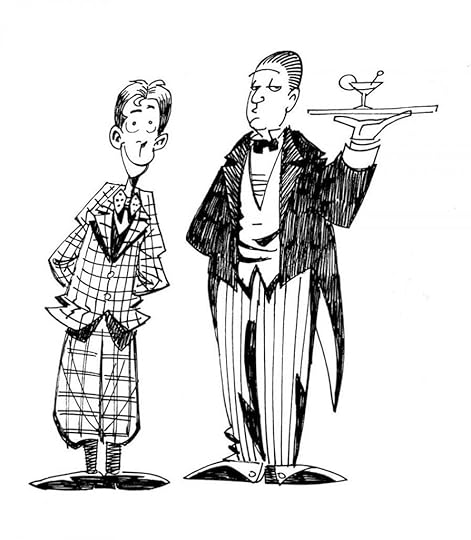
Dosage: One to three chapters every evening before bedtime
Efficacy: 100%
Side effects: Tender abdomen from laughing; sore facial muscles from smiling; stiff neck from shaking head at the wonder of the author's genius
Contraindications: Do not take this drug if you suffer from hard-heartedness or lack of a sense of humor.

"Wodehouse's world can never stale. He will continue to release future generations from captivity that may be more irksome than our own. He has made a world for us to live in and delight in." - Evelyn Waugh.
And to laugh in: “Wodehouse is the greatest comic writer ever.” - Douglas Adams.
And to keep sane in: "The funniest writer ever to put words on paper. This is uncontested by all but the most irretrievably insane." - Hugh Laurie
 Here's a delightful Wodehouse sample. Go on, try it. An overdose can only be fatal to your blues.
Here's a delightful Wodehouse sample. Go on, try it. An overdose can only be fatal to your blues.
July 6, 2014
Shakespeare, Elizabeth I, and My Friend Brigit
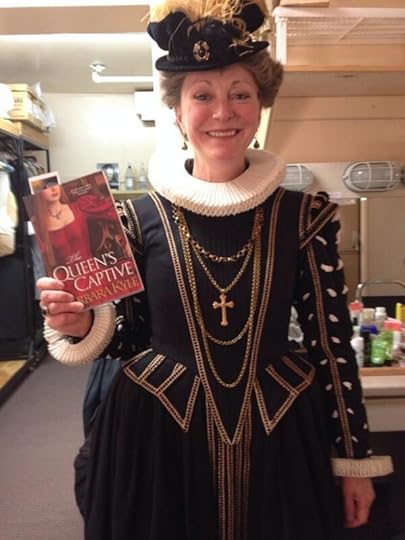
My friend and fine actor, Brigit Wilson, tweeted this photo of herself in her dressing room at Ontario's world-renowned Stratford Festival where she plays Lady Faulconbridge in Shakespeare's "King John."
What good taste she has in books!
Here she is with my novel The Queen's Captive.

I love the juxtaposition of her Elizabethan costume with The Queen's Captive because the book begins with twenty-year-old Princess Elizabeth on her way to the Tower, arrested by her half-sister, Queen Mary. Terrified, Elizabeth was sure she was going to her execution. It was March, 1554.
Two months later, reluctantly bowing to the people's love of Elizabeth, Mary released her, but she kept her under house arrest at the moldy old "palace" of Woodstock for almost a year.
In 1558 Mary died, childless after a failed and unhappy reign, having been virtually abandoned by her husband, Philip II of Spain. Elizabeth ascended the throne at age twenty-five. She ruled for forty-three years, one of England's wiliest and most successful monarchs.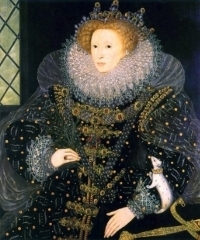
My friend Brigit is also in rehearsals for the Stratford Festival's production of "Christina, the Girl King" in which she plays Duchess Erika Brahe. If you love great theater, check out the Festival's stunning season: http://www.stratfordfestival.ca/BoxOf...
For more about my books, please visit my website: http://www.barbarakyle.com/
July 1, 2014
My Kind of Woman

The "star" of my new novel, The Queen's Exiles is Scottish-born Fenella Doorn. (That's her on the cover.) Of all the characters I've created in my six Thornleigh Saga novels, she's one of my favorites.
Fenella is a savvy entrepreneur who salvages ships. To me, she's a true hero. Yet, for a long time, I didn't see her potential. She almost got elbowed into obscurity as a mere "bit player."
Fenella played a small but crucial role in The Queen's Gamble, and then I kind of forgot about her. She didn't appear in the next book, but when I was planning the story after that she sneaked up me.
She's a determined, passionate, courageous woman, and rather cheeky—she insisted that I include her in the new story. She reminded me that she had past connections with two exciting men in the series, Adam Thornleigh and Carlos Valverde, which promised some dramatic sparks. So, I did more than include her in the new book, I made her its star.
Fenella offered me an opportunity to create a complex, admirable woman who doesn't fit the ingénue heroine so common in historical fiction.
She's not a young thing; she's thirty. She's not a pampered lady; she rolls up her sleeves running her business of refitting ships. She's attractive but not a smooth-faced beauty; her cheek is scarred from a brute's attack with a bottle years ago. And she's not a virgin; she was once the mistress of the commander of the Edinburgh garrison (he of the bottle attack).
She had been a beauty at eighteen, relying on men to support her, but when her cut face marred her attractiveness she realized that it was now up to her to put bread on the table and clothes on her back. I made her aware, even grateful, that the scar freed her from the bonds of beauty; it made her independent. And she became a successful entrepreneur. In other words, Fenella is my kind of woman.
I hope you'll enjoy her story.
"Riveting Tudor drama" - USA Today
"An epic tale of patriotism and treason, political upheaval and oppression, familial love and the ties that bind" - Let Them Read Books blog
For more about my books please visit my website: http://www.barbarakyle.com/

June 16, 2014
Join Me On My Book Tour
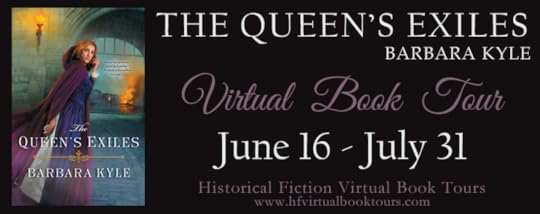
The virtual tour with my new historical thriller, The Queen's Exiles, kicks off today!
Join me for interviews, my posts on the great hosting blogs, and a bunch of giveaways with lots of chances to win a signed copy of The Queen's Exiles.
Details of the tour schedule are here: http://hfvirtualbooktours.com/thequee...
Hope to see you on the tour!
*****
If you'd like to receive my Newsletters you can sign up here: http://www.barbarakyle.com/newsletters/
June 5, 2014
How Fenella Became a Star: the Truth about Writing a Series

Readers love series. It's a benign addiction. We get to know the continuing characters so well we can't wait to find out what happens to them in the next book.
What happens can sometimes surprise the author. The surprise for me was Fenella Doorn.
 Fenella is the heroine of my new historical thriller, The Queen's Exiles. She's a savvy Scottish-born entrepreneur who salvages ships. This is the sixth book in my Thornleigh Saga which follows a middle-class English family's rise through three tumultuous Tudor reigns.
Fenella is the heroine of my new historical thriller, The Queen's Exiles. She's a savvy Scottish-born entrepreneur who salvages ships. This is the sixth book in my Thornleigh Saga which follows a middle-class English family's rise through three tumultuous Tudor reigns.Fenella played a small but crucial role in The Queen's Gamble, and then I kind of forgot about her. She didn't appear in the following book, Blood Between Queens. But when I was planning the story after that Fenella sneaked up me.
She's a determined, passionate, courageous woman, and also rather cheeky - she insisted that I include her in the new story. She reminded me that she had past connections with two exciting men in the series, Adam Thornleigh and Carlos Valverde, which promised some dramatic sparks.
So, I did more than include her in the new book. I made her its star.
That can happen when you write a series - a secondary character can take over. I was glad Fenella did. She offered me an opportunity to create a complex, admirable woman who doesn't fit the ingénue heroine so common in historical fiction.
She's not a young thing; she's thirty. She's not a pampered lady; she rolls up her sleeves running her business of refitting ships. She's attractive but not a smooth-faced beauty; her cheek is scarred from a brute's attack with a bottle years ago. And she's not a virgin; she was once the mistress of the commander of the Edinburgh garrison (he of the bottle attack).
In other words, Fenella is my kind of woman.
But making her the star of the new book in my series meant some serious recalibrating. How could I fit her into the Thornleigh family? Writing a series opens up a vista of opportunities but also a minefield of traps. I'll share a few with you here.
Creating a Series Bible
Before writing full time I enjoyed a twenty-year acting career, and one of the TV series I did was a daytime drama called High Hopes. (That's me on the cover of TV Times, below.) The writers on that series kept a story Bible: a record of the myriad details that had to be consistent from show to show concerning the dozens of characters. It's a wise practice for the writer of a series of novels, too.
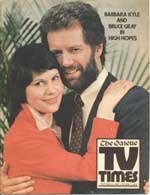
My Thornleigh Saga books follow a family for three generations so it's easy to forget facts about a character that were covered three or four books ago. That's why I keep a Bible that tracks the characters' ages, occupations, marriages, love affairs, children, ages of their children, homes, character traits, and physical details like color of hair ... and missing body parts! Richard Thornleigh loses an eye in The Queen's Lady (Book 1) yet in later books I would often start to write things like, "His eyes were drawn to ..." So I keep that Bible near.
Every Book is New
An author can't assume that readers have read the previous books in the series. My agent, Al Zuckerman (in the photo below) always reminds me of this when I send him the outline for a new book in the Thornleigh Saga. "Many readers won't know what these characters have already been through," he wisely says.
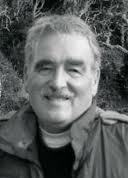
So each book has to give some background about what's happened to the main characters in the preceding books, enough to fill in new readers. However, it can't lay on so much back story that it bores readers who have followed all the books. Getting the balance right is tricky.
I like the way episodes in a TV series start with a helpful recap: "Previously on Downton Abbey..." It's perfect: it refreshes the memory of viewers who've seen the previous episodes, and is just enough to tantalize those who haven't and fill them in. I wish I could have a nice announcer give a recap at the beginning of my Thornleigh books! The point is, each book in a series must stand on its own. It has to be a complete and satisfying story for any reader.
Consistency Can Yield Rewards
When I had a brute cut Fenella Doorn's cheek in The Queen's Gamble I never expected Fenella to reappear in a future story. Two books later, when I brought her back in The Queen's Exiles, I could not ignore the fact that she would have a sizable scar on her cheek. So I used that scar to enrich her character.
She had been a beauty at eighteen, relying on men to support her, but when her cut face marred her beauty she realized that it was now up to her to put bread on the table and clothes on her back. I made her aware, even grateful, that the scar freed her from the bonds of beauty; it made her independent. And she became a successful entrepreneur.
Letting Characters Age
It's hard for readers to believe that a hero can fight off bad guys like a young stud if the decades-long timeline of the books he appears in make him, in fact, a senior citizen. J. K Rowling was smart. She let Harry Potter and his friends grow up.
I've enjoyed doing this with my characters. Through six books I've taken Honor Larke from precocious seven-year-old to wise grande dame as Lady Thornleigh. Her step-son Adam Thornleigh's first big role was in The Queen's Captive where he was an impetuous seafaring adventurer, but by the time of The Queen's Exiles Adam has become a mature man, a loyal champion of his friend Queen Elizabeth. He has been through a loveless marriage, adores his two children, and falls hard for Fenella.
I'm grateful that Fenella Doorn insisted I feature her in The Queen's Exiles. (By the way, that's her on the cover.) The book has been out for just a week and already I'm hearing from readers that they love her.
Fenella is a star.
"Riveting Tudor drama in the bestselling vein of Philippa Gregory." - USA Today

***
For more about my books, or to sign up for my Newsletter, please visit my website: http://www.barbarakyle.com/



